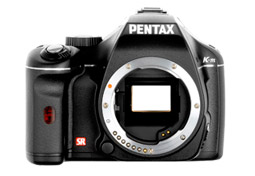To avoid publishing measurements which could be unfairly improved by noise reduction processing on RAW, we check every camera’s autocorrelation function for each ISO along the entire sensor dynamic range. (For further information, see the dxomark Insight, “Half-Cooked Raw”)
No noise reduction was detected for the Pentax Km from ISO 100 to ISO 400, per Figure 1 below. The autocorrelation function shows a single peak, which denotes white noise only.

But for ISOs higher than 400, the autocorrelation shows a wider base (Figure 2), which means noise reduction filtering. As explained in the above-linked Insight, such filtering implies not just that measured noise decreases, but that details can be lost.

The autocorrelation function at ISO 1600 and ISO 3200 shows the same wider base, indicating that noise processing reduction is still turned on.
The Lowlight ISO score for the Pentax Km is extrapolated from the non-filtered ISOs to allow fair comparison with other cameras.
We have updated the DxO Mark Sensor database for most Pentax cameras in order to better account for noise reduction. All measurements impacted by noise filtering processing have been flagged by a white dot (as on, for example, the SNR chart for the Pentax Km below).

Noise filtering processing is present on the Pentax K10D (ISO 800 and ISO 1600), the Pentax K20D (ISO 3200 and ISO 6400), the Pentax K200D (ISO 800 and ISO 3200), the Pentax K7 (ISO 3200 and ISO6400) and the Pentax Kx (ISO 3200, ISO 6400 and ISO 12800).
As the Low-Light ISO scores for the Pentax K10D and Pentax K200D changed slightly after taking noise filtering into account, their global dxomark.com rankings changed as well. However, Pentax K20D Low-Light ISO scores were not impacted by noise filtering.
We want to emphasize that this kind of processing on RAW data files decreases noise but leads to a permanent loss of detail. We recommend, whenever possible, to turn off sensor noise reduction, and let the RAW converter fully process the image.
However, while most other cameras have an interface that permits turning off internal noise filtering and thus providing unprocessed RAW data files, Pentax cameras still apply some noise reduction even when the noise reduction option is supposedly switched off.
Disclaimer: This dxomark review evaluates only the selected camera’s RAW sensor performance metrics (i.e., Color Depth, Dynamic Range, and Low-Light ISO), and should not be construed as a review of the camera’s overall performance, as it does not address such other important criteria as image signal processing, mechanical robustness, ease of use, flexibility, optics, value for money, etc. While RAW sensor performance is critically important, it is not the only factor that should be taken into consideration when choosing a digital camera.





DXOMARK encourages its readers to share comments on the articles. To read or post comments, Disqus cookies are required. Change your Cookies Preferences and read more about our Comment Policy.